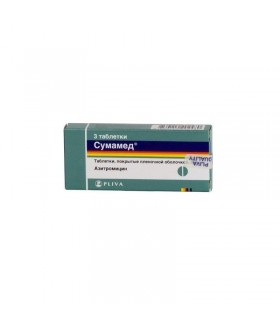




Security policy (edit with Customer reassurance module)

Delivery policy (edit with Customer reassurance module)

Return policy (edit with Customer reassurance module)
Infectious and inflammatory diseases caused by microorganisms sensitive to the drug:
- infections of the upper respiratory tract and ear (bacterial pharyngitis, tonsillitis, sinusitis, otitis media);
- infections of the lower respiratory tract (bacterial bronchitis, interstitial and alveolar pneumonia, exacerbation of chronic bronchitis);
- infections of the skin and soft tissues (chronic migrating erythema - the initial stage, Lyme disease, erysipelas, impetigo, secondary dermatosis);
- sexually transmitted infections (urethritis, cervicitis);
- Diseases of the stomach and duodenum associated with Helicobacter pylori.
- severe violations of the liver and kidneys;
- Hypersensitivity to macrolide antibiotics;
WITH caution: during pregnancy and lactation, in disorders of the liver and kidneys, patients with impaired or susceptible to arrhythmias and lengthening of the QT interval.
In pregnancy, the drug should be administered only if the expected benefit to the mother outweighs the potential risk to the fetus. If it is necessary to introduce Sumamed women during lactation, it is necessary to decide on the termination of breastfeeding.
The drug is administered orally 1 time per day. Bioavailability of the drug in the form of pills does not depend on food intake.
Children 6 months and older are recommended to use the drug in the form of a suspension for oral administration or pills 125 mg
With infections of the upper and lower respiratory tract, skin and soft tissues (except for chronic migrating erythema)
for adults the drug is prescribed in a dose of 500 mg 1 time / day for 3 days, the course dose is 1.5 g.
For children appoint at the rate of 10 mg / kg of body weight 1 time / day for 3 days, course dose - 30 mg / kg.
In chronic erythema migrans:
for adults the drug is prescribed 1 time per day for 5 days: 1 day - 1 g (2 tab.500 mg), then from 2 to 5 days - 500 mg, course dose 3 g.
For children administered on 1 day at a dose of 20 mg / kg of body weight and then from 2 to 5 days - daily at a dose of 10 mg / kg of body weight, course dose 60 mg / kg.
With diseases of the stomach and duodenum associated with Helicobacter pylori
appoint 1 g (2 tab. 500 mg) per day for 3 days in combination with antisecretory agent and other drugs.
In sexually transmitted infections
for the treatment of uncomplicated urethritis / cervicitis prescribed in a dose of 1 g once;
for the treatment of complicated long-term urethritis / cervicitis caused by Chlamydia trachomatis, appoint 1 g 3 times with an interval of 7 days (1, 7, 14 days), course dose - 3 g
Rarely (in 1% of cases and less).
Gastrointestinal: melena, cholestatic jaundice, nausea, vomiting, diarrhea, constipation, loss of appetite, gastritis, reversible moderate increase in liver enzymes.
Urogenital: nephritis.
From the reproductive system: vaginal candidiasis.
Cardiovascular: palpitations, chest pain.
Nervous system: dizziness, headache, vertigo, drowsiness, fatigue; in children - headache (in the treatment of otitis media), hyperkinesia, anxiety, neurosis, sleep disorders.
Allergic reactions: skin rash, angioedema, urticaria, conjunctivitis.
Dermatologic: photosensitivity, itching.
From the laboratory indicators: in some cases - neutrophilia, eosinophilia (altered parameters return to normal after 2-3 weeks after discontinuation of treatment).
In case of skipping a single dose of the drug - the missed dose should be taken as early as possible, and the next - with intervals of 24 hours.
The patient should be warned about the need to inform the doctor about the occurrence of any side effect.
Antacids (containing aluminum, magnesium), ethanol and food intake greatly reduce the absorption of Azithromycin (capsules and suspension), so the drug should be taken at least 1 hour before or 2 hours after taking these drugs and food.
Azithromycin, unlike other macrolide antibiotics, is not associated with cytochrome P isoenzymes.450. To date, no interactions with theophylline, terfenadine, Carbamazepine, triazolam, Digoxin have been observed.
Macrolides when administered concomitantly with cycloserine, indirect anticoagulants, methylprednisolone, ceradipine, and drugs that undergo microsomal oxidation (cyclosporine, hexobarbital, ergot alkaloids, valproic acid, disopyramide, Bromocriptine, pyrotoin acenecaphen, and pyrotoin nitroxyne, acetohydrin, acetoacidol, valproic acid, disopyramide, bromocriptine, pyrotobin, pyrotocabeline while at application of azalides such interaction was not noted by now.
If necessary, the joint reception with Warfarin is recommended to carefully monitor the prothrombin time.
While taking macrolides with ergotamine and dihydroergotamine at the same time, their toxic action (vasospasm, dysesthesia) is possible.
Lincosamines reduce, and Tetracycline and chloramphenicol increase the effectiveness of azithromycin.
Pharmaceutically azithromycin is incompatible with Heparin.
Symptoms: nausea, vomiting, diarrhea, temporary hearing loss.
Treatment: symptomatic.
XKeep out of reach of children at a temperature of 15 ° to 25 ° C.
3 years.